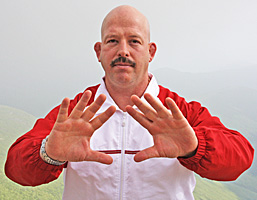Yet another one of the myths/lies in the self-development field is the notion of taking “massive action.”
When I teach my coaching members there’s no such thing as taking massive action, they usually look at me with a bewildered expression. I am the first person they have ever heard say this. Everyone else is doing what Earl Nightingale called, “following the follower.”
Similar to Socrates, I end up reducing the ridiculous to reality with a series of questions:
“2,500 years ago, Lao Tzu wrote that the journey of a 1,000 miles begins with a single step,” I begin. “So let’s see if something has fundamentally changed about walking in the past two and a half centuries. If you were on a 1,000-mile journey, how many steps would you take at a time?”
“I would take one step at a time,” someone replies.
“But what if I put both feet together and jump? Does that double the number of steps?” I ask.
“No.”
“That means, even if I double my efforts and jump as far as I can, I only get one jump at a time?”
“That’s correct.”
“But what will happen if I put my feet together and jump forward 1,000 times in a row?”
“You’ll probably injure yourself trying to speed up your progress.”
“So think about this: You take massive action, now you’re exhausted and quite possibly injured. And then you’ll be frustrated. You may begin to think that there’s no way you can achieve your goal. But this is not the case. You can achieve your goal, but you’ll do so one consistent step at a time, not via massive action.”
“That makes sense.”
“Not only does it make sense, it’s a reality,” I add. “Let’s say you decide to walk as many miles as you can every single day. Plus, to prove you’re taking massive action, you put 100 pounds of gear on your back to carry along with you. The 100 pounds represents you making sure you’re doing more than one thing at the same time. That’s your strategy to walk 1,000 miles. And you push yourself each day until there’s nothing left. Meanwhile I, have a different idea. I’m going to walk at least five miles each day. I can walk more than five miles if I’m on a roll, but if I stop at five, I’ve hit my daily goal. As for what I carry with me. A bottle of water and a towel will suffice. Each day, when you and I are finished walking, someone picks us up so we can rest and start again the next day. Now, let me ask, who do you think has the better chance of succeeding?”
“I would say that you do.”
“You nailed it. And the reason is obvious, isn’t it. I have a consistent, daily goal that is manageable. It’s not too big. It doesn’t scare me. It doesn’t drain me of physical energy. And it doesn’t wreak havoc on my nervous system. In fact, each day as I accomplish my goal, I gain energy and momentum while the massive action person loses it.”
Make a note: In Psycho-Cybernetics, there isn’t a single word about taking massive action. Not one.
The reason is simple: It’s not a natural, spontaneous, free-flowing and momentum-building approach to achievement.
The same goes for getting out of your comfort zone. There’s nothing in Psycho-Cybernetics that gives this type of advice, either.
The key is finding your comfort zone and expanding with force. You do this by having a daily achievable goal that leads you to the 1,000-mile, the 10,000 or the 1,000,000-mile marker in a relaxed, “I got this” manner.
On a daily basis, remember to eliminate the angst and anxiety of trying to build Rome overnight. You cannot build a city overnight – but you can build one, or anything else, if you keep moving, one humble step at a time.
See it. Feel it. Do it.
Matt Furey
P.S. I’ve been getting a number of questions about recommenced products you can give as presents over the Christmas season. In addition to Psycho-Cybernetics, I strongly suggest 101 Ways to Magnetize Money… In Any Economy, Expect to Win – Hate to Lose, as well as The Unbeatable Man. All three of these books are in the “can’t put it down” variety.

